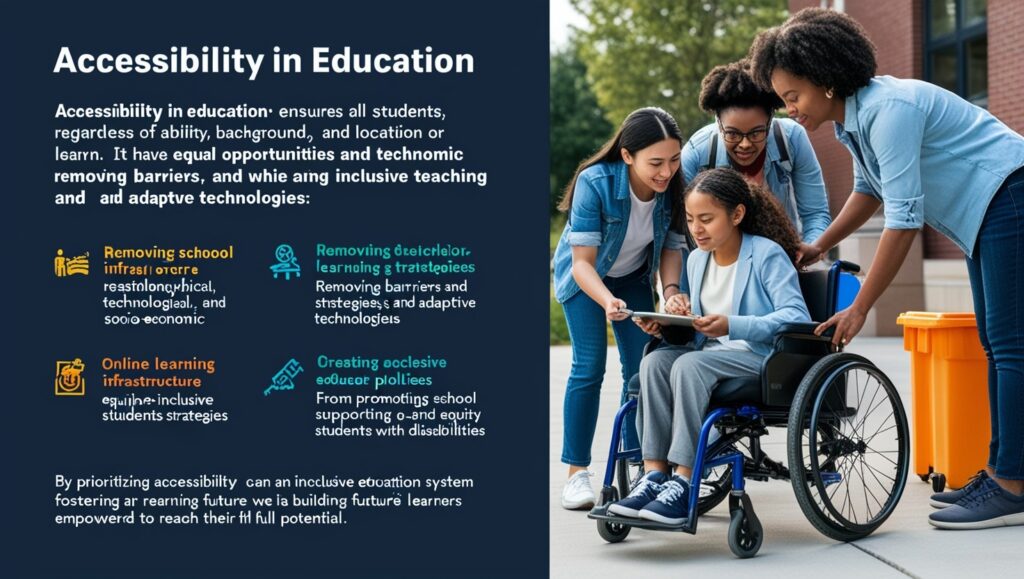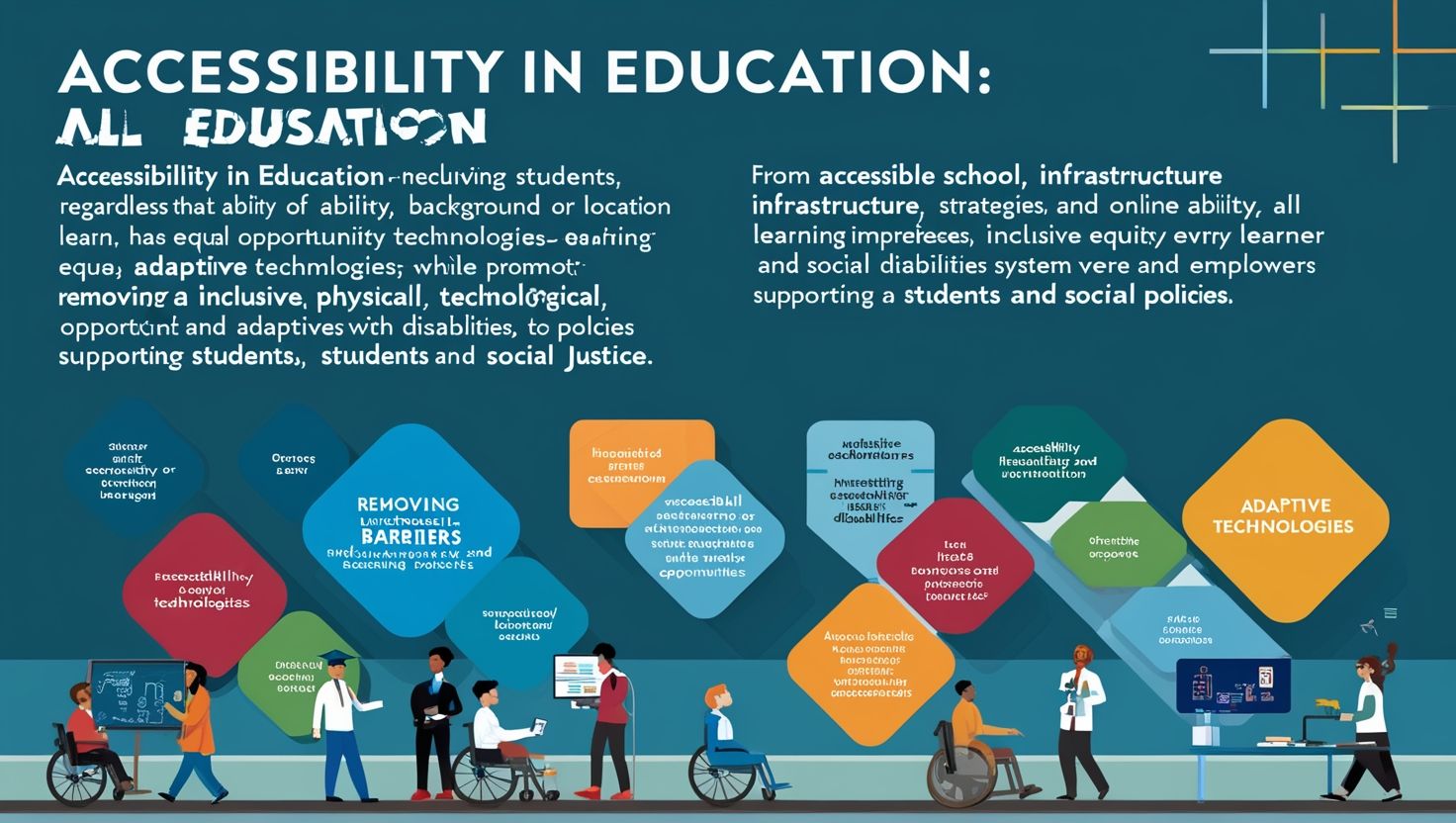Accessibility in Education, Education is the foundation of personal and societal development. It empowers individuals, creates opportunities, and fosters a sense of inclusion. However, for many, accessing education is not as simple as walking into a classroom or opening a textbook. The concept of accessibility in education has evolved significantly over the years, focusing on removing barriers for those who have historically marginalized or disadvantaged, including individuals with disabilities, students from diverse socio-economic backgrounds, and those in remote areas. Ensuring that every learner has access to education that meets their needs is not only a moral imperative but also a prerequisite for a truly equitable society.
The Foundations of Educational Accessibility
The idea of accessible education can be traced back to centuries-old philosophies advocating for equality. However, it wasn’t until the 20th century that global movements began formalizing the concept. The principle of accessibility rests on the idea that everyone, regardless of their physical, mental, or social circumstances, should have equal access to learning opportunities.
Traditionally, education systems designed with a one-size-fits-all approach, which often left out students who didn’t fit the mold. Children with physical disabilities, learning differences, or those from marginalized communities were either excluded from mainstream education or provided with substandard resources. This systemic neglect reinforced inequality and limited the life opportunities of millions.
The Global Push for Inclusive Education
A major shift in the accessibility of education came with the adoption of international frameworks like the Universal Declaration of Human Rights (1948) and, more recently, the United Nations Convention on the Rights of Persons with Disabilities (2006). These global agreements underscored the right to education for all, emphasizing that schools and learning environments should accommodate the needs of every student. The Sustainable Development Goals (SDGs), particularly Goal 4, which aims to “ensure inclusive and equitable quality education,” has further pushed nations toward creating more accessible education systems.
Despite these efforts, challenges remain. In many parts of the world, schools are still inaccessible to children with disabilities. In some rural or conflict-affected regions, physical schools are few and far between. Additionally, children from low-income families may lack access to basic educational materials, technology, or even consistent meals, making learning a secondary priority to survival. These systemic barriers hinder the realization of accessible education globally.
Barriers to Accessibility
Understanding the barriers to accessible education is key to dismantling them. These barriers can broadly be classified into four categories: physical, technological, socio-economic, and attitudinal.
- Physical Barriers: Schools often lack the infrastructure necessary to accommodate students with physical disabilities. This includes ramps, elevators, accessible restrooms, and adjustable classroom furniture. Physical barriers can also extend to transportation, as students with disabilities may find it difficult to travel to and from school if proper transit accommodations aren’t in place.
- Technological Barriers: As education becomes increasingly digitized, technological barriers have emerged as a significant concern. For students with disabilities, websites and educational apps often not designed with accessibility features such as screen readers, voice commands, or closed captions. Moreover, students from impoverished or rural areas may not have access to computers, tablets, or even the internet, creating a vast digital divide.
- Socio-economic Barriers: Financial constraints are a major factor preventing students from accessing quality education. Low-income families may not afford school fees, books, uniforms, or other essential supplies. In many cases, children in these families also required to work, leaving little time for education. This inequality is compounded by the fact that wealthier areas often have better-funded schools with more resources.
- Attitudinal Barriers: Social stigma and negative attitudes toward students with disabilities or those from marginalized communities can create an unwelcoming or hostile environment. Discrimination, bullying, or a lack of understanding from peers and educators alike can discourage students from attending school or fully engaging in the learning process.
Technology as a Tool for Accessibility
In recent years, technology has played a pivotal role in breaking down some of the barriers to educational accessibility. Assistive technologies, for example, have revolutionized the way students with disabilities learn and interact with educational content. Tools such as speech-to-text software, audio books, braille displays, and augmented reality (AR) can create more inclusive learning environments by catering to different learning styles and abilities.
For students with mobility impairments, online learning platforms have made education more accessible than ever before. Virtual classrooms, e-books, and remote tutoring provide opportunities for students who may not be able to physically attend school. In developing countries, mobile technology also being leveraged to deliver education to remote areas, where physical schools might be sparse. Apps designed for mobile phones allow students to access learning materials, connect with teachers, and even take exams remotely.
However, the integration of technology into education also requires careful planning to ensure that it doesn’t exacerbate existing inequalities. For students who lack access to the internet or digital devices, online learning can become another barrier to education rather than a solution. To truly harness the power of technology for accessibility, governments and educational institutions must invest in infrastructure that makes these tools available to all.

Policy and Legislative Approaches
Governments play a crucial role in ensuring accessibility in education through policies, laws, and investments. In many countries, laws such as the Americans with Disabilities Act (ADA) in the United States or the Equality Act in the UK mandate that educational institutions must accommodate students with disabilities. These laws require schools to remove physical and administrative barriers, provide reasonable accommodations, and ensure that all students receive a quality education.
Additionally, many nations have adopted inclusive education policies that integrate students with disabilities into mainstream classrooms rather than segregating them in special schools. This approach promotes social inclusion and prepares all students for life in diverse societies. However, successful inclusive education requires adequate teacher training, support services, and resources to meet the diverse needs of all learners.
In developing nations, where resources are often more limited, the challenge is to create policies that address the unique barriers faced by different groups of students. For example, in countries with high rates of child labor, policies might focus on providing financial incentives or free meals to encourage school attendance. In conflict-affected regions, governments and NGOs are working to create “safe schools” that protect students from violence and provide a stable learning environment.
The Role of Educators
Teachers are at the forefront of making education accessible. Beyond imparting knowledge, educators shape the learning environment and influence how inclusive and welcoming a school is. Training teachers to understand the diverse needs of their students and to adopt inclusive teaching strategies is critical. This might include modifying lesson plans to cater to different learning styles, using assistive technologies, or creating classroom activities that promote collaboration and understanding among students from diverse backgrounds.
Professional development programs can also help educators stay updated on the latest tools and strategies for accessibility. Moreover, fostering a culture of empathy and respect within the classroom is key to reducing the stigma and discrimination that some students face. Teachers can promote a more inclusive environment by modeling positive attitudes, encouraging peer support, and addressing instances of bullying or exclusion.
The Future of Accessibility in Education
As societies become more aware of the importance of accessibility in education, the future looks promising. Advances in technology, increased advocacy, and stronger policies are slowly breaking down the barriers that have historically excluded students from receiving quality education. However, there is still much work to be done to achieve true equity in education.
One of the most significant challenges moving forward will be addressing the digital divide. As education increasingly shifts online, ensuring that all students have access to the necessary technology will be crucial. Governments and private sector partners must collaborate to provide affordable internet access and devices to underserved communities. Furthermore, educational content must designed with accessibility in mind, ensuring that all students, regardless of ability, can fully engage with learning materials.
Another important area for growth is in the training of educators. Teachers must be equipped with the knowledge and resources to create inclusive classrooms that meet the needs of all learners. This includes understanding the unique challenges faced by students with disabilities, those from diverse cultural backgrounds, and those living in poverty.
Conclusion
Accessibility in education is more than just a legal requirement; it is a commitment to equity and social justice. By breaking down the barriers that prevent students from accessing quality education, we can create a world where every individual has the opportunity to reach their full potential. Whether through technology, policy, or the efforts of dedicated educators, making education accessible for all is an essential step toward building a more inclusive and equitable society.
In the end, the true measure of an education system’s success is not just in how well it serves the majority but in how it reaches and uplifts those who are often left behind. By prioritizing accessibility, we can ensure that education is not a privilege for the few but a right for all.
References:
- United Nations. (1948). Universal Declaration of Human Rights.
- United Nations. (2006). Convention on the Rights of Persons with Disabilities.
- UNESCO. (2015). Education 2030: Incheon Declaration and Framework for Action.
- World Bank. (2020). Learning Poverty: What It Is, Why It Matters, and What to Do About It.

6 thoughts on “Accessibility in Education”
Comments are closed.